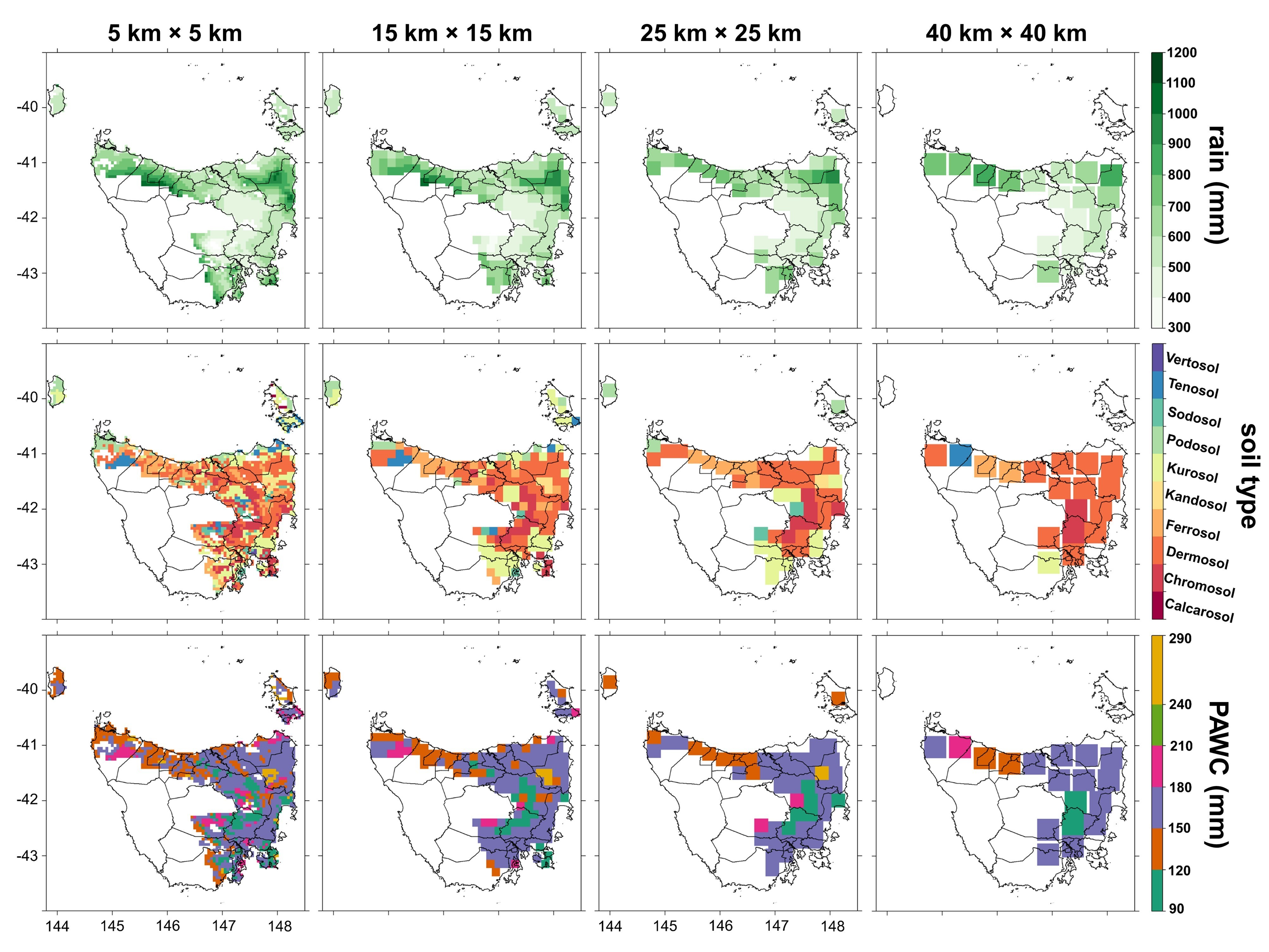Towards high crop productivity in agriculture based on multi-scale modelling and climate change impact studies
 Photo by Ewert et al., 2006 iEMSs
Photo by Ewert et al., 2006 iEMSsThis project is a collaboration between German and Australian research organisations and has three main objectives:
- Assess the climate (DAEc) and soil (DAEs) data aggregation effects on crop yield and irrigation water requirement (IWR) across several environments.
- Investigate how input and output data aggregation affected simulated rainfed and irrigated yield and IWR variability.
- Determine and quantify the main drivers of rainfed and irrigated yield variability under historical and future climate scenarios using a multi-model and sensitivity analysis approach.
Some results so far
Paper 1 - published in Science of the Total Environment
Effects of soil- and climate data aggregation on simulated potato yield and irrigation water requirement

This study highlights the need to (i) separately quantify the impact of input data aggregation on model outputs to inform about data aggregation error and (ii) identify those variables that explain these aggregation errors. In line with previous studies, DAEc was mainly driven by differences in elevation and DAEs was largely influenced by soil properties. Climate input data, mainly rainfall, play a key role as a driver of potato yield variability at high spatial resolution. At coarser resolutions, soil data aggregation can strongly affect simulated potato yield (under rainfed conditions) and IWR. This study can guide crop modellers when choosing the spatial resolution for regional simulation related to regional water use and climate change impact assessments. More research is needed to assess model responses to other potato management practices, such as nitrogen fertilisation rate, planting density and genotype. Crop modelling using input data at coarse resolution needs to consider climate DAE and soil DAE to quantify the bias associated with data aggregation. This bias, which may be significant, may skew decisionmaking at the regional level.
Paper 2 - under review in European Journal of Agronomy
Sensitivity of simulated potato yield and irrigation water requirement to input and output data aggregation in Tasmania, Australia

Regional crop modelling is the focus of active investigation from a variety of perspectives, including risk analysis, water management and climate change impact assessments. We identified the need to (i) quantify biases on model outputs due to input and output data aggregation and (ii) discriminate the main environmental factors associated with these region-specific biases. We conclude that plant available water capacity and the source of water (rainfall or rainfall + irrigation) explained the larger errors associated with the input and output data aggregation on simulated potato yield and IWR. Future studies should strongly consider the data aggregation method in their assessment, to minimize the errors for their purposes and therefore produce higher quality advice or farming decisions. and were highest under low-rainfall environments therefore input and output data aggregation approaches must be assessed and selected carefully for these environments. Our analysis also highlights the need to quantify the error of the scaling methods to improve the reliability of regional yields and IWR estimations. These findings are expected to reduce the uncertainty in regional water management assessments that require data from crop models.
Paper 3 - in preparation
Uncertainty in climate change impact studies for irrigated systems: the case of maize in Spain

Irrigation is a key adaptation strategy to climate change. Heat and drought extremes are a determining factor in Spain’s maize yield variability. Combinations of better irrigation management with most favorable sowing date and cultivar probably provide optimal conditions for crop production. However, simulating yield variability in irrigated systems has remained a deterrent, as it depends on water allocation, and farmers’ decision for crop management in the case of limited water-availability. The aim of this study is to determine and quantify the main drivers of irrigated maize yield variability under historical and future climate scenarios using a multi-model and sensitivity analysis approach for Andalusia, Spain. We calibrated three process-based crop models using observed crop yields from 4 experiment sites during 2005-2018. Scenarios of farmer irrigation management were created from 118 farm sites in the district. The contribution of three non-climatic factors (irrigation strategy, sowing date and cultivar) to uncertainty in simulated yields were investigated during historic period and hypothetical future climate change scenarios with increasing temperature and decreasing water availability. The sensitivity analysis shows that most yield variability comes from irrigation strategy and varies more significantly during heat stress condition. Our findings highlights the need to account for interactions between drought and heat stress in further research to improve the simulation of maize yield variability.
Partners:
University of Göttingen (Prof Stefan Siebert, Dr Ehsan Eyshi Rezaei), Leibniz Centre for Agricultural Landscape Research (ZALF) and University of Bonn (Dr Bahareh Kamali, Dr Heidi Webber, Dr Claas Nendel, Dr Frank Ewert), Germany; The Andalusian Institute of Agricultural and Fisheries Research and Training (IFAPA) (Dr Clara Gabaldon, Dr Ignacio Lorite), Spain.
Funded by
Australia-Germany Joint Research Co-operation Scheme, Universities Australia, German Academic Exchange Service (DAAD).
Grant amount
AUD$40,360